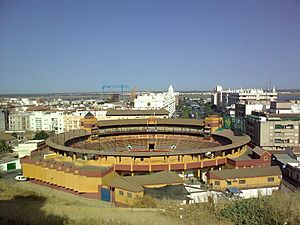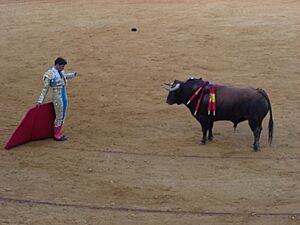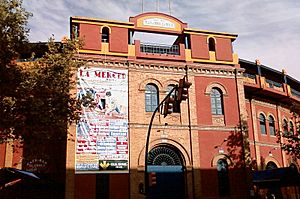Plaza de Toros de La Merced facts for kids
 |
|
| Full name | Plaza de Toros de La Merced |
|---|---|
| Location | Huelva, Spain |
| Coordinates | 37°15′56″N 6°57′06″W / 37.265583°N 6.951694°W |
| Public transit | Avda. Alemania (Plaza de Toros) bus stop |
| Owner | Private |
| Operator | Espectáculos Taurinos La Merced, S.L. |
| Capacity | 7127 |
| Field shape | Circular |
| Surface | 1963.5 m2 |
| Current use | Bullring |
| Construction | |
| Built | 1899–1902 |
| Opened | 5 September 1902 |
| Renovated | 1984 |
| Architect | Trinidad Gallego Díaz (1899–1902) Luis Marquínez Marquínez (1984) |
The Plaza de Toros de La Merced is a famous bullring located in Huelva, a city in Andalusia, Spain. A bullring is a special arena where bullfights and other events take place. This building was first built between 1899 and 1902. It was designed by an architect named Trinidad Gallego y Díaz.
Later, in 1984, the bullring was completely updated and reopened. Architect Luis Marquínez led this big renovation project. For some years, the old bullring was not used. Bullfights were held in a newer, but unsafe, bullring that was later torn down. The Merced bullring has seen many famous bullfighters over its long history. It can hold 7,127 people today.
Contents
The Original 1902 Bullring in Huelva
The Merced bullring you see today is a modern version of the original one. It stands on the same spot where an older, wooden bullring once stood. That wooden bullring could hold about 6,000 people. However, people wanted a more modern building.
Claudio Saavedra Navarro helped lead the effort to build a new bullring. This new La Merced was the first bullring in Huelva made from strong building materials. Before this, all bullrings in the city were made of wood. The new building was planned to cost 150,000 pesetas, which was a lot of money back then.
The bullring was built using many ordinary bricks. It also had a very strong foundation made of concrete. The architect, Trinidad Gallego Díaz, used these materials to create a beautiful and sturdy building. The bullring's design was graceful and lively.
The main area where bullfights happen is called the ruedo. It measures 50 meters across. Around the ruedo is a narrow passage called the callejón, which is 1.8 meters wide. This passage is a safe place for bullfighters. Behind the callejón are 14 rows of seats for the audience. There are also 36 special seating boxes upstairs. The most important one is the presidential box, where the official in charge of the bullfight sits.
The main gate of the bullring faces west. This divides the seating into two parts: a sunny side and a shady side. Inside the building, there are many important rooms. These include bull corrals, a chapel, an infirmary, and rooms for bullfighters. There are also places for horses and equipment.
The original bullring could hold about 6,500 spectators. It was a great artistic and architectural achievement. It showed off the clever ideas of architect Trinidad Gallego Díaz.
Building the Bullring: A Look Back
The idea for Huelva's bullring was a big business project. Many local people helped make it happen. On November 20, 1886, a company called Sociedad Anónima Plaza de Toros de Huelva was formed. Many important local business people were part of this company. Soon after, architect Trinidad Gallego was put in charge of designing the bullring.
The building was finally completed in 1902. Its design was similar to another bullring in Madrid. It featured Neo-Mudéjar elements, which is a style inspired by old Spanish-Islamic art. The grand opening happened on September 5, 1902. This event was part of the Huelva Fair. Famous bullfighters Miguel Báez Quintero "El Litri" and Rafael González Madrid "Machaquito" performed.
The opening of the Merced bullring was a huge event. People from Huelva and nearby cities were very excited. A magazine called Sol y Sombra wrote several pages about the fair and the bullfight. It described how crowded the city was with visitors. Everyone was eager to see the bullfights. The streets were full of happy people, music, and food stalls.
In 1954, a young bullfighter named Rafael Carbonell Ramos was seriously injured during a bullfight at the bullring.
The Short-Lived 1968 Monumental Bullring
Over time, the original Merced bullring started to fall apart. So, a new bullring was built. On August 2, 1968, the new Plaza de toros Monumental de Huelva opened. It was much larger, with seats for 14,000 people. Famous bullfighters like Miguel Báez Espuny "El Litri" and Manuel Benítez "El Cordobés" performed there.
However, this new bullring did not last long. It was built too close to the Ría de Huelva, a river estuary. There were problems with its design, making it unsafe. It had to close in 1982. This left Huelva without a place for bullfights for a while. The Monumental bullring was torn down in 1997.
The Revived La Merced Bullring of 1984
After the Monumental bullring closed, people looked back at the old La Merced bullring. A local businessman, José Luis Pereda García, had the idea to buy and restore it. Even though he wasn't involved in bullfighting before, he saw the potential.
It was a difficult process, but the mayor of Huelva, José Antonio Marín Rite, agreed. The La Merced bullring was then restored based on architect Luis Marquínez's plans. It reopened on July 29, 1984. This was a big celebration. Bullfighters "El Litri," Curro Romero, and Pepe Luis Vázquez performed. "El Litri" fought the first bull at the newly revived bullring.
Since its reopening, the Merced bullring has become one of the most important bullrings in Andalusia. It is very popular. Today, a company called Espectáculos Taurinos La Merced, S.L., runs it.
Huelva's Bullfighting Fair
Huelva's bullfighting fair, called Feria Taurina, has a long history. It traditionally started in May or June and continued until the Huelva Fair in September. The most important bullfighting events in the city happened during these months.
The first recorded bullfight during the Columbian Festivals was on August 2, 1891. This was to celebrate 400 years since Columbus's discovery of America. Matadors Antonio Arana y Carmona "Jarana" and "Litri" performed.
After a long break, bullfights at the Columbian Festivals became regular again after 1920. Many famous bullfighters have performed there. For example, in 1924, Juan Belmonte and his brother Manuel Belmonte fought. In 1925, Manuel Báez Gómez "El Litri" received a special award called the Golden Ear.
The bullfighting celebrations at the Columbian Festivals were later organized by local traders. A memorable event was in 1932. Bullfighters Domingo Ortega, Manuel Bienvenida, and José Bienvenida performed. Ortega gave one of his best performances with the fourth bull that afternoon.
As of 2024, the bullfighting festivities at La Merced also include a "Children's Running of the Bulls." This event is safe and fun, using inflatable bulls pushed on carts. Children can also try "play bullfighting" and meet real bullfighting stars. In 2024, the event celebrated 40 years since the bullring's revival. José Luis Pereda García, who helped restore the bullring, was there. Bullfighters Guillermo Luna, Enrique Toro, and Carlos Tirado also attended.

Bullfighting Museum Plans
In 2014, there were plans to open a bullfighting museum at La Merced. The managers were talking to famous bullfighters. They hoped to get them to donate some of their special bullfighting outfits, called "suits of lights," or capes for the museum.
External links
- Catalogue of buildings, elements and spaces of interest in Huelva's PGOU
- A tour through the centenary bullring
- 111 years of bullfighting history in Huelva
- 25 years of the Merced bullring
- The Merced bullring turns 116 years old
See also
 In Spanish: Plaza de toros de La Merced para niños
In Spanish: Plaza de toros de La Merced para niños


